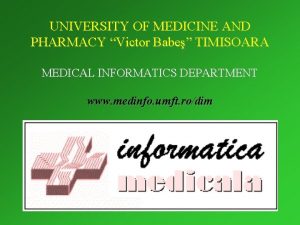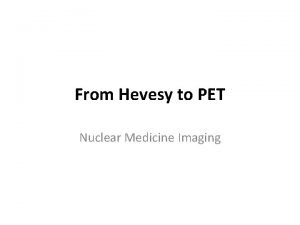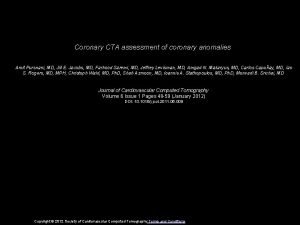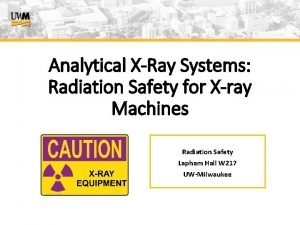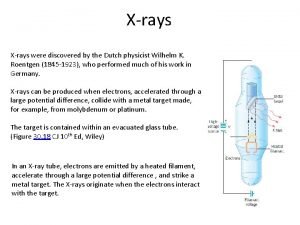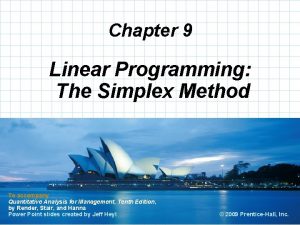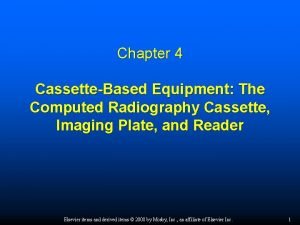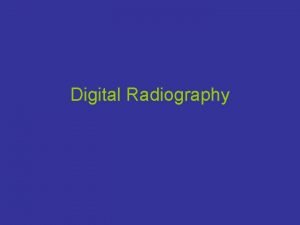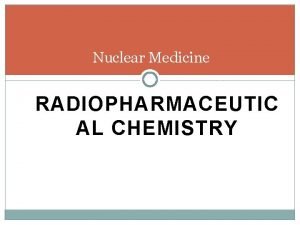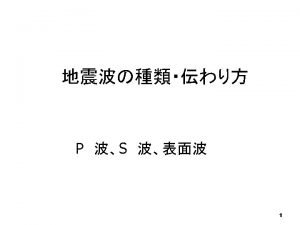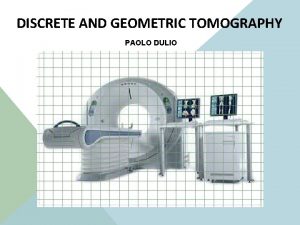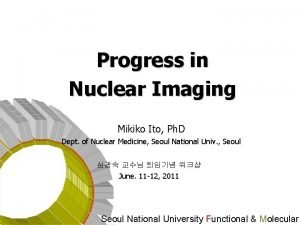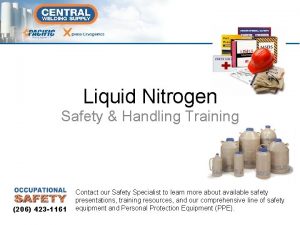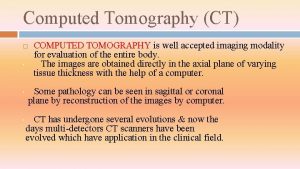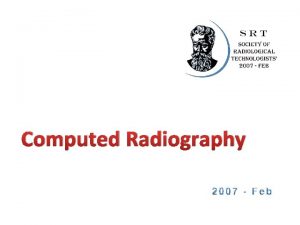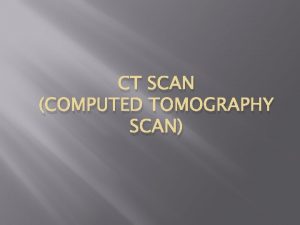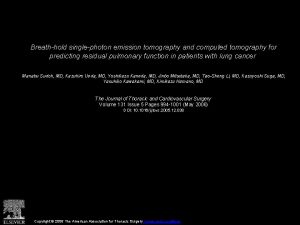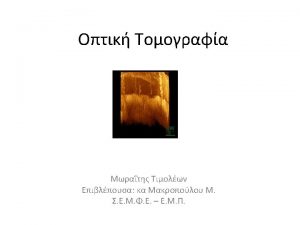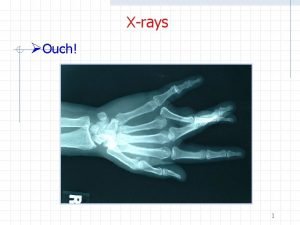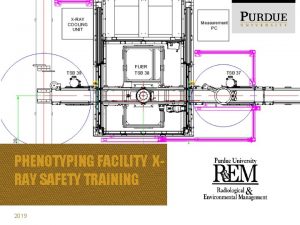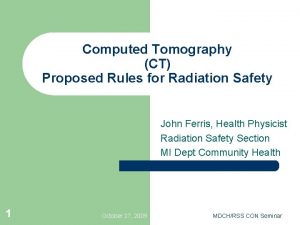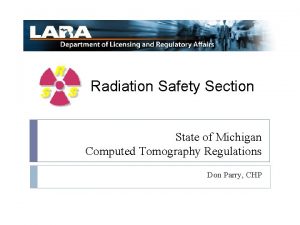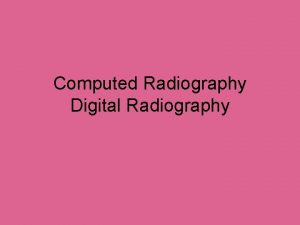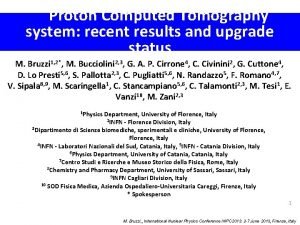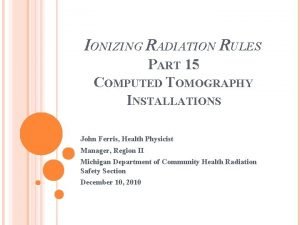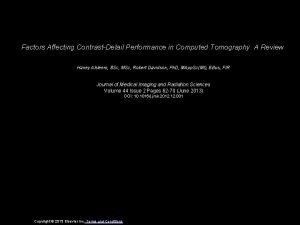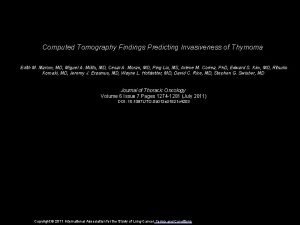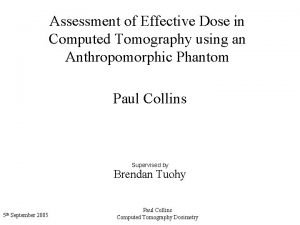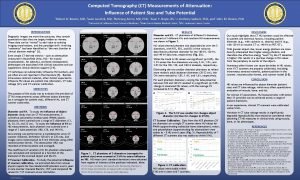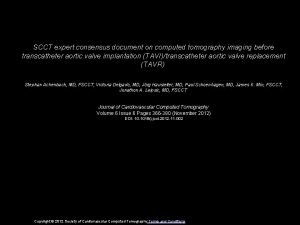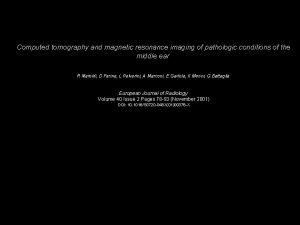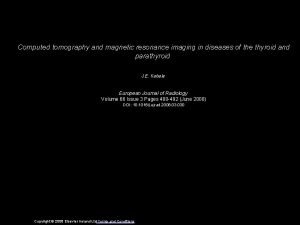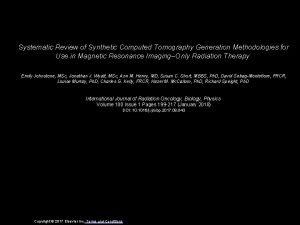COMPUTED TOMOGRAPHY CT SAFETY TRAINING 2016 XRAYS Xrays










































- Slides: 42

COMPUTED TOMOGRAPHY (CT) SAFETY TRAINING 2016

X-RAYS • X-rays are a type of ionizing electromagnetic radiation. • X-rays are a valuable tool, but there associated health risks. − These risks can be minimized by adhering to certain principles and practices as explained in this presentation. • X-rays are capable of traveling great distances and penetrating through lowdensity materials such as wood and plastic. • However, they can be blocked or attenuated by shielding made from highdensity materials such as lead and concrete.

X-RAY SHIELDING While all materials absorb X-rays, dense materials such as lead, steel and concrete are the most effective. Hence, they are the preferred shielding materials.

X-RAY PRODUCTION (1) • • • X-rays are generated in the X-ray tube of the device. Electrons, that have been accelerated using a high voltage source, are abruptly decelerated by striking a metal target (e. g. , copper, molybdenum, and tungsten). Some of the energy of the electrons that impinge upon the target are converted into X-rays.

X-RAY PRODUCTION (2) • • X-ray production is proportional to operating potential (k. Vp) and current (m. A) When the X-ray unit is not operating or it is powered down, the high voltage is not applied and X-rays are not produced. Therefore, there is no danger present when the machine is not operating or it is powered down. For certain X-ray diffraction units, it is recommended that diffraction units idle at low power instead of powering down

BIOLOGICAL EFFECTS, DOSE LIMITS AND RADIATION SAFETY PRINCIPLES

DOSE • When radiation interacts with living material such as our bodies, they may deposit enough energy to cause biological damage. Biological damage can occur as a result of chemical bonds being broken, DNA damage, and cells being damaged or killed. • Radiation induced health effects are dependent on radiation dose. − The ‘rem’ is the common unit of dose in the U. S. o 1 rem = 1000 millirem (mrem) − The ‘sievert’ is the common international unit of dose. o 1 sievert = 100 rem

HEALTH EFFECTS OF RADIATION EXPOSURE • Health Effects from exposure to radiation range from no effect at all to death, including diseases such as cancer. • The health effects can be divided into two categories: 1. Early Effects 2. Delayed Effects

EARLY EFFECTS (1) • Occur shortly after exposures resulting in large doses (>100 rem), delivered within a short time period (acute exposure) • Acute exposures cause extensive biological damage to cells so that large numbers of cells are killed. • The severity of the health effects is proportional to the dose. • Possible health effects include: vomiting, diarrhea, skin burns, cataracts, hair loss, fever, lethargy, loss of appetite, changes in blood count, and death.

EARLY EFFECTS (2) • An estimated dose of around 325 rem for young healthy adults without medical intervention will result in death to 50% of the group within 60 days. • For a dose of less than about 800 rem, an exposed person is likely to survive with appropriate hospital care. • Under normal operation, the occurrence of early effects is highly unlikely.

DELAYED EFFECTS • Occur years after acute and chronic (low doses over a long time period) exposures. • Possible health effects include: leukemia, cancer, life span shortening, cataracts, and genetic defects.

DELAYED EFFECTS - GENETIC EFFECTS • Radiation studies involving fruit flies and mice suggest the possibility of heritable genetic effects in humans if there is radiation damage to the cells of the sperm or eggs. • These effects may show up as genetic defects in the children of exposed individuals and succeeding generations. • Scientists have studied populations of individuals exposed to radiation (e. g. , atomic bomb survivors and radiation workers) to identify the presence of heritable genetic effects. • To date, no heritable genetic effects from radiation have ever been observed in any human population exposed to doses ranging from natural background to that received by atomic bomb survivors.

DELAYED EFFECTS – STOCHASTIC • Leukemia, cancer, and genetic effects are considered stochastic effects; the probability of occurrence is dependent of dose. − As dose increases, the probability of occurrence increases. • Conservative studies estimate a 0. 04% increase of developing an adverse health effect per rem received. • For additional information, refer to Regulatory Guide 8. 29

GOVERNMENT DOSE LIMITS • In an effort to reduce the risk of potential health effects caused by radiation, the Indiana State Department of Health (ISDH) has set dose limits for those working with radiation producing devices. • These limits are put in place to create an upper limit of how much radiation a worker is allowed to be exposed to within a certain time period. • Individuals who stay below the dose limits: − Will not develop any early effects. − Will maintain a very small risk of developing delayed effects. 14

DOSE LIMIT VALUES The ISDH has permitted Purdue University to use Nuclear Regulatory Commission (NRC) dose limits. NRC Dose Limits (10 CFR 20. 1201) Section of Body Limit (rem) Whole Body (Head, torso and organs) 5 Lens of the Eye 15 Extremities (Hands, forearms, feet and ankles) 50 15

RADIATION & PREGNANCY (1) • Epidemiological studies of the A-bomb survivors, pregnant women who received pelvic X-rays, and animal studies indicate that embryos and fetuses are extremely radiosensitive. • The principle effects of radiation on the developing embryo and fetus, are embryonic, fetal, or neonatal death; congenital malformations; growth retardation; and functional impairment, such as mental retardation; and cancer. • The effects depend on the stage of gestation, the dose, and the dose rate. • These occurrences are extremely unlikely at Purdue because the doses possible from normal operation are very low.

RADIATION & PREGNANCY (2) • Pregnant individuals should take all precautions possible to keep exposures to the embryo or fetus as low as possible. • Extra precautions are taken by Purdue University for a Declared pregnant woman. • Declared pregnant woman means a woman who has voluntarily informed Purdue, in writing, of her pregnancy and the estimated date of conception. • If a declaration is made, it must be given to the Radiation Safety Officer (RSO) in writing.

RADIATION & PREGNANCY (3) • Once in effect, the pregnant worker’s exposure limit will be reduced to 10% of the occupational dose limit. • In addition, that worker will be given a fetal dosimeter to monitor the dose received by the embryo or fetus. • The declaration remains in effect until the declared pregnant woman withdraws the declaration in writing or is no longer pregnant. • For additional information, refer to Regulatory Guide 8. 13 18

ALARA • • The risk of developing delayed effects can be decreased by decreasing dose. Scientists accept the linear no-threshold theory which states that even low-doses carry some risk of developing delayed effects. The goal is not only to remain below the dose limits, but to keep it even lower by trying to keep doses As Low As Reasonably Achievable (ALARA). ALARA is not just a good idea, it is REQUIRED by law (410 IAC 5 Rule 4).

ALARA PRINCIPLES • There are several practices that will help you to keep your dose As Low As Reasonably Achievable (ALARA). − Time: Decreasing the time spent in a radiation area results in a lower accumulated dose. Plan work efficiently to avoid spending too much time near X-ray equipment. − Distance: The greater the distance between you and the X-ray unit, the lower the dose. − Shielding: The greater the shielding, the lower the dose. Lead and concrete works well to attenuate X-rays.

DOSIMETRY (1) • Dosimetry – Device worn by radiation users to measure their accumulated dose. It is used to ensure that you do not exceed the governmentestablished dose limits. There are two types: 1. Ring – measures dose to the hands, worn on the hand receiving the highest dose with name facing the palm side 2. Whole-body – measures dose to the torso and head, worn on the part of the torso that will receive the highest dose

DOSIMETRY (2) • • If issued dosimetry, you MUST wear it every time you are operating X-ray equipment Dosimetry must be returned at the end of the wear period (monthly or bimonthly), to be analyzed. − Dose measurement may be lost if dosimeter is returned late − Lost dosimetry may result in a monetary fine

X-RAY DEVICE SAFETY FEATURES, EXPOSURE PATHWAYS, AND SAFE PRACTICES

SAFETY FEATURES – TUBE HOUSING X-ray Tube Housing – The X-ray tube is enclosed in a shielded housing. The useful (primary) beam of X-rays exits through the collimator while the remainder is shielded by the housing. • This greatly reduces the dose to surrounding individuals

SAFETY FEATURES – WARNING LIGHTS Warning Light – Indicates that X-rays are being produced. • These are failsafe, meaning X-rays will not be produced if the light is not operational (i. e. , If the light is burnt out, X-rays will not be generated). • The warning lights are located on the control panel and/or the exterior of the CT unit 25

SAFETY FEATURES – BEAM STOP Beam Stop – The beam stop blocks X-rays transmitted through the sample/patient. The detector array functions as the beam stop. • This greatly reduces the dose to surrounding individuals 26

EXPOSURE PATHWAY – PRIMARY BEAM Primary Beam – The useful beam of X-rays emitted from the X-ray tube. • The highly collimated primary beam is fan-shaped and thin. • Although primary beams are capable of producing high radiation levels, the brief scan time prevent the occurrence of acute radiation doses.

EXPOSURE PATHWAY – SCATTER Scatter Radiation – As X-rays from the primary beam interact with atoms in the sample, many of these will scatter in multiple directions. • The operator and individuals near the CT machine will be exposed to these scattered X-rays • Capable of causing chronic radiation doses

EXPOSURE PATHWAY – LEAKAGE Leakage Radiation – Despite the tube housing and beam stop, radiation will escape. • Nearby individuals will be exposed to these leakage radiation. • Capable of causing chronic radiation doses

MANDATORY SAFE PRACTICES (1) • NEVER attempt to remove or bypass any system component (e. g. safety features). − These are meant to protect you from harmful radiation doses • DO NOT operate the unit in any manner other than specified in the procedures • DO NOT allow anyone other than trained and certified personnel to operate the X-ray device • Maintenance of the X-ray device MUST be performed by trained professionals.

MANDATORY SAFE PRACTICES (2) • • ALWAYS follow the ALARA principles discussed earlier − When producing X-rays, don’t stand closer to the device than necessary − When producing X-rays, reduce the amount of time spent around the system AVOID placing any part of your body (especially the eyes or hands) near the examination area during measurement. DO NOT operate the X-ray system unless all system components and features are in good repair DO NOT modify the X-ray device in any manner without approval of the radiation safety officer.

ADDITIONAL SAFETY FOR PET/SPECT If imaging with positron emission tomography (PET) and/or single photon emission computed tomography (SPECT) is done concurrently with computed tomography (CT), additional radiation hazards from the radionuclides (e. g. 18 F, 15 O, 11 C, and 99 m. Tc) exist. • PET and SPECT utilize large quantities (i. e. millicuries) of photon emitting radionuclides. • Users MUST complete Purdue University’s Unsealed Radiation Safety Training prior to use. • Always follow ALARA principles of time, distance and shielding to reduce their radiation dose

ACCESS REQUIREMENTS The following requirements must be met before you are authorized to use the X-ray device: • Permission from the supervisor responsible for the X-ray device • Completion of REM’s X-ray safety training (this training presentation) • Submit completed A-4 form to REM • Specific training from the supervisor for the operation of the X-ray device. • Any additional requirements deemed necessary by the supervisor.

ENFORCEMENT Failure to comply with the rules, regulations safe practices established by Indiana State Department of Health or Purdue University can result : • Re-training • Loss of work privileges with X-ray producing devices • Obtaining an injunction or court order to prevent a violation • Civil penalties • Criminal penalties − For willful violation of, attempted violation of or conspiracy to violate any regulation 34

SECURITY Only the individuals that are listed as Approved Authorized Users on the specific X-ray project as defined by REM may have the ability to operate the X-ray unit(s). • Lab should be locked when not attended by authorized users. • Any additional security requirements deemed necessary by the supervisor. • If an unauthorized user is found using the unit, immediately notify the Supervisor/PI. REM should be contacted to schedule a training for the user in order for them to become authorized. • It is important for all those using the X-ray equipment to be: − Trained on the specific unit − Trained on X-ray awareness in order to be informed of safety requirements, hazards involved and ways to prevent unnecessary exposures 35

REGULATIONS AND REM

STATE REGULATIONS The Indiana State Department of Health (ISDH) regulates the use of X-ray equipment in Indiana through Title 410 Indiana Administrative Code Article 5: Radiological Health. 410 IAC 5 Rule 2: Registration of Radiation Machine Facilities and Services. • 410 IAC 5 Rule 4: Protection and Exposure Standards. • 410 IAC 5 Rule 5: Non-Medical Radiography (includes X-ray fluorescent lead based analyzers). • 410 IAC 5 Rule 6. 1: X-rays in the Healing Arts. • 410 IAC 5 Rule 8: Radiation Safety Requirements for Analytical X-Ray Equipment. • 410 IAC 5 Rule 9: Radiation Safety Requirements for Particle Accelerators. • 410 IAC 5 Rule 10: Notices, Instructions and Reports to Workers; Inspections. 37

UNIVERSITY ORGANIZATION • • • The radiation safety program is empowered by Purdue University Executive Memorandum No. B-14 Purdue University’s radiation policies can be found in the Purdue Radiation Safety Manual The radiation safety program is managed by the: − Radiation Safety Committee (RSC) o Ensures the safety of the University and community in the utilization of all radioactive materials and radiation producing devices at the University or by University faculty, staff or students. − Department of Radiological and Environmental Management (REM) o Carries out the directives of the RSC. 38

REM RESPONSIBILITIES REM is responsible for: • Performing a radiation survey and compliance inspection when X-ray equipment is first installed, and when equipment is relocated or altered in any way that affects radiation safety. • Performing an annual survey and inspection of each X-ray machine. • When necessary, providing dosimetry to monitor radiation dose of users • Providing X-ray safety training for X-ray users. • REM is also responsible for complying with regulations set forth by the ISDH, for the safe use of radiation producing devices such as X-ray units. − This is accomplished by providing training, calibration services, personnel dosimetry to monitor radiation exposure and consulting support for any safety issues identified by Purdue University employees and students. 39

CONTACT REM IF… • You know or suspect there has been an overexposure to an individual • The X-ray unit is to be moved or modified • Personnel working on the project has been changed (added/dropped) 40

RADIATION SAFETY GROUP • James Schweitzer, Ph. D. Radiation Safety Officer (RSO) 49 -42350 jfschweitzer@purdue. edu • Matthew Tang Health Physicist 49 -42721 mmtang@purdue. edu • Kyle Smith Health Physicist 49 -41478 Smith 514@purdue. edu • Jerry J. Gibbs Waste Handling & Meter Calibration 49 -40207 jjgibbs@purdue. edu 41

END OF TRAINING MODULE • • • This concludes the Power. Point portion of the training. Complete the test indicated below. You must have 75% of correct responses to pass. • Your results will be emailed to you, and will constitute as your certification of your successful completion of the online portion of your training, if you have passed. Submit a completed Form A-4 (make sure that both you AND your Principal Investigator have signed the form), and send through campus mail to: Sharon Rudolph/REM/HAMP Click here to begin the test.
 Computed tomography of the head
Computed tomography of the head Radiology timisoara
Radiology timisoara Computed tomography artifacts
Computed tomography artifacts Ring artefact
Ring artefact Computed tomography
Computed tomography Journal of cardiovascular computed tomography
Journal of cardiovascular computed tomography Data acquisition in ct
Data acquisition in ct Contribution margin per unit formula
Contribution margin per unit formula Frequency of xrays
Frequency of xrays Gamma ray
Gamma ray Jfk xrays
Jfk xrays Wilhelm k roentgen
Wilhelm k roentgen In simplex table the pivot row is computed by
In simplex table the pivot row is computed by The cr cassette is backed by aluminum that
The cr cassette is backed by aluminum that A tracking signal is computed by
A tracking signal is computed by A computed is a calculation that a dbms performs
A computed is a calculation that a dbms performs What is computed radiography
What is computed radiography Safety care certification
Safety care certification Shadow tomography of quantum states
Shadow tomography of quantum states Seismic tomography ______.
Seismic tomography ______. Positron emission tomography
Positron emission tomography Positron emission tomography
Positron emission tomography Seismic tomography
Seismic tomography Paolo dulio
Paolo dulio Positron emission tomography
Positron emission tomography Positron emission tomography
Positron emission tomography What is tomography
What is tomography Kenneth rudinger
Kenneth rudinger The national patient safety goal 6
The national patient safety goal 6 Which display mode is allowed for proper navigation?
Which display mode is allowed for proper navigation? Personal safety vs process safety
Personal safety vs process safety Ind safety report
Ind safety report Basic safety (construction site safety orientation)
Basic safety (construction site safety orientation) Construction site safety orientation
Construction site safety orientation 29 cfr 1910
29 cfr 1910 Food safety training in dubai
Food safety training in dubai Liquid nitrogen safety training
Liquid nitrogen safety training Back safety training
Back safety training Fuel tank safety training questions
Fuel tank safety training questions Fire training ppt
Fire training ppt Army traffic safety introductory course
Army traffic safety introductory course 15-passenger van training exam answers
15-passenger van training exam answers Pa state inspection checklist form
Pa state inspection checklist form

